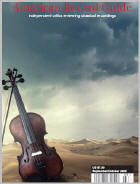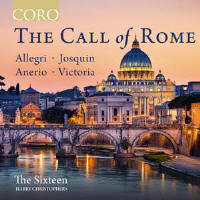Reviewer: William
J. Gatens
In his notes to this
recording, Noel O’Regan points out that Rome during the Renaissance was a
magnet for musicians from all over Europe. As the headquarters of the
Catholic Church, the papal establishment and bureaucracy controlled
appointments well beyond the confines of the Eternal City, and a period of
service in the papal choir or an association with a well-placed cardinal
could pave the way to a position in Italy or elsewhere.
The four composers of the present program span a period from the late 15th
to the early 17th Century. Two of the composers— Felice Anerio (1560-1614)
and Gregorio Allegri (1582-1652)—were born in Rome. Josquin Desprez
(c1452-1521), the earliest of the four, was from northern France. He sang in
the papal choir from 1489 to 1494 before returning to his native
Condé-sur-l’Escaut to assume a position there. He was among the singers to
carve his name into the wall of the Sistine Chapel choir loft. Tomas Luis de
Victoria (1548-1611) came to Rome around 1565 to study for the priesthood
but remained for 20 years of musical activity including an association with
St Philip Neri and his Oratorian congregation.
The program opens with the plainsong first lesson from Lamentations in the
first nocturn of Tenebrae for Holy Saturday. This is followed by Victoria’s
four-part settings of the responsories for the second and third nocturnes of
that day. As in so many of Victoria’s orks, there is an emotional intensity
beneath the highly disciplined surface of the music. The best known of these
responsories is 'O Vos Omnes’, which is often performed separately. The
other work by Victoria on this program is his eight-part setting of the
Marian antiphon 'Salve Regina’. O’Regan notes that Victoria helped to
develop the Roman polychoral idiom. In this instance, the choirs perform
separately most of the time, effectively reserving the full eight-part
texture for climaxes. Josquin is represented by three motets. 'Illibata Dei
Virgo’ survives in a papal chapel manuscript. It is a tour de force of
numerologicalingenuity, and the verbal text includes an acrostic on the
composer’s name. 'Gaude Virgo Mater Christi’ is marked by the composer’s
trademark duets and imitation between the voices as well as illustrative
word painting. His six-part setting of both 'Pater Noster’ and 'Ave Maria’
is acknow-ledged as one of his masterpieces. Felice Anerio was a pupil of
Palestrina and succeeded him in 1594 as a composer to the papal choir. He is
represented here by an exuberant double-choir setting of 'Regina Caeli
Laetare’ the Marian antiphon for Eastertide. Also on the program is his 'Litaniae
Beatissimae Virginis Mariae’. Litany texts are notoriously repetitious, but
Anerio counters that by keeping up a persuasive musical flow from one
invocation to another. Easily the most familiar work on this program is the
'Miserere’ by Gregorio Allegri, though perhaps not as performed here. The
corrupt “standard version” has been recorded many times and has acquired an
ad hoc integrity of its own. I particularly like the 1997 recording by the
choir of New College, Oxford, under Edward Higginbottom (Erato 14634). The
mystique surrounding this piece has less to do with what Allegri actually
wrote than with the vocal ornamentation that grew up around it, a jealously
guarded preserve of the papal choir. Of course, there were attempts to note
down the ornamentation, most famously by Mozart. Ben Byram-Wigfield has
researched this matter. The booklet gives the site for a free download of
his essay. This performance, recorded in 2012, some seven years before the
rest of the program, seeks to put Byram-Wigfield’s findings into practice.
Christophers begins with Allegri’s basic chordal framework, but each
successive verse introduces different ornaments such as might have been
heard in the 17th and 18th Centuries. Listeners may be surprised
by some of the chromatic passing tones. The curious may want to check out
the version by Tommaso Bai (c1650-1714), based on Allegri, recorded in 1995
by the Abbey Consort (Sony 66615; M/A 1997, p 292). The other piece by
Allegri on the present recording is the Gloria from his double-chorus
Mass In Lectulo Meo based on a motet by Pierre Bonhomme (c1555-1617), a
native of Liege who spent some time at Rome and was given by Pope Clement
VIII a canonry in his native city.
It seems incredible that it
has been nearly 40 years since Harry Christophers founded The Sixteen. I
have been an admirer of their work for most of that time. The present
recording more than upholds their reputation. Coherence and choral
discipline may simply be assumed in any of their recordings and
performances. This is decidedly an adult concert choir, not an attempt to
imitate a men-and-boys cathedral choir. Christophers makes more use of
dynamic shading to shape phrases than do many early music choral directors.
There is a danger of producing an anachronistically romanticized reading of
Renaissance music, though I do not think he falls into that trap. The
opposite approach can too easily produce performances that are dispassionate
and unengaging. The quality of the recorded sound is outstanding. The choral
tone is warm and clear with good presence but not overwhelming.
Fermer la fenêtre/Close window
|




